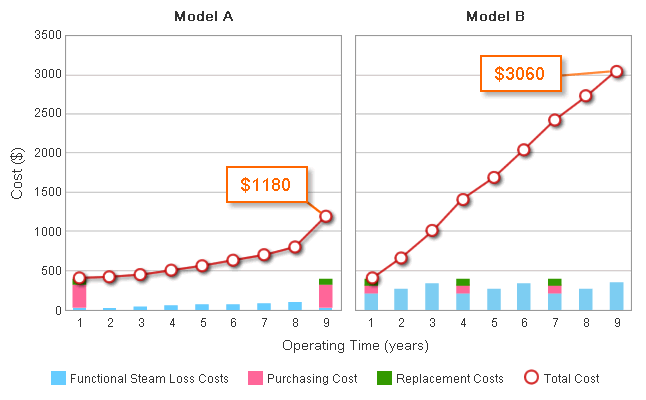- Home
- Steam Resources
- Steam Theory
- Steam Trap Selection: Safety Factor and Life Cycle Cost
Basics of Steam Traps
Steam Trap Selection: Safety Factor and Life Cycle Cost
Following the previous section regarding some physical factors that influence steam trap selection for applications, this section focuses on the trap Safety Factor and Life Cycle Cost (LCC) considerations.
What is the Safety Factor?
The safety factor is a coefficient used when selecting the trap’s required discharge capacity. It helps provide a buffer zone for instances when condensate volume exceeds calculated/predicted values. The estimated condensate load should always be multiplied by the recommended safety factor for trap selection.
The following is a table that summarizes how trap type affects the safety factor:
| TLV Trap Type | Minimum Recommended Safety Factor |
|---|---|
| Float | 1.5 |
| Bucket | 2 |
| Disc | 2 |
| Thermostatic (X-element) | 2 |
| Bimetal | 3 to 5 |
The safety factor is influenced by at least two elements: peak condensate load and the trap type relative to response time.
Peak Condensate Load
The peak (or maximum) condensate load on equipment may be higher than the average load for several reasons. Cold equipment at start-up, for example, typically causes much greater condensate loads than during regular operation. The condensate load can also severely increase during the period when the product is the coldest in batch processes.
For steam traps on steam distribution mains, whenever a single trap blocks, the next trap in line may be required to drain condensate for two condensate drainage locations (CDL).
The Safety Factor Numerical Value
Manufacturer safety factor recommendations can vary between 1.5 to 5.0, or more. These depend on factors such as trap design, conservative capacity rating, orifice wear characteristics, how critical an application is, etc.
Since condensate discharge capacity on specification sheets is calculated assuming continuous discharge, some steam trap types that operate intermittently (on/off), such as disc and bucket type traps, may require the use of a larger safety factor to minimize back-up issues in between cycles.
Moreover, some manufacturers’ traps have higher safety factor recommendations simply to provide larger orifice sizes to lessen blockage. In comparison, traps that discharge condensate continuously, such as conservatively rated float type traps, typically only require a safety factor of 1.5.
The safety factor may also help compensate for when an insufficient pressure differential across the trap impedes condensate discharge, such as when backpressure increases.
During steam trap selection, it is therefore extremely important to apply the trap manufacturer’s recommended safety factor after calculating the application load, making sure that the trap size also offers a sufficient capacity for the application.
Trap Life Cycle Cost (LCC)
Steam traps are an essential and permanent part of steam systems, and should be selected according to their Life Cycle Cost (LCC) to offer the lowest system cost over the long-term. This means that initial purchasing cost should only be one of the decision factors when selecting a trap. Other costs related to maintenance, installation, replacement, as well as operational monetary losses from functional and failure steam leakage, etc. should also be taken into account.
Rapid wear of internal components such as the valve seat causes steam leakage to increase over time, eventually leading to premature steam trap replacement. The timing for replacement is usually determined by evaluating replacement costs and comparing these to increased losses from steam leakage and other losses such as those caused by trap failure. Alternatively, some trap designs leak more steam than others even while in perfect accordance with the design specifications. These traps can be eliminated in the design phase.
The following is an example of the influence of Life Cycle Cost (LCC) on steam trap selection. Model A and model B are two different types of traps. Model A has a higher initial purchasing cost, but a longer service life than model B.
| Item | Model A | Model B |
|---|---|---|
| Purchasing Cost | $300 | $100 |
| Replacement Costs* | $80 | $80 |
| Initial Functional Steam Loss | 0.05 kg/h | 1.0 kg/h |
| Yearly Increase in Steam Loss from Wear | 0.06 kg/h (per year) | 0.4 kg/h (per year) |
| Typical Service Life | 8 years | 3 years |
* Costs related to man-hours and replacement of parts such as gaskets, etc.
The Life Cycle Cost of both these traps over a 9-year span can be calculated. Assuming both traps are operated 24 hours a day, 365 days a year at an average steam cost of $20 per ton, the estimated cost of model A is $1180, including purchasing and replacement costs in year 9. The estimated cost of model B, on the other hand, is $3060 including purchasing and replacement costs in year 4 and 7. Despite it's lower initial cost, model B is therefore 2.4 times more expensive than model A when Life Cycle Cost is taken into account, showing the importance of calculating long-term costs when selecting a trap.
| Life Cycle Cost of Model A vs. Model B |
|---|
|
|
Trap reliability / service life, maintenance costs, and functional / failure steam losses are all important economic factors when determining the best model for steam trap selection.


